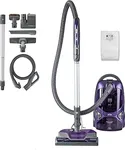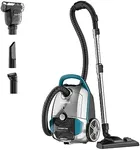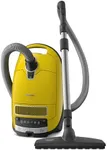Buying Guide for the Best Bagged Vacuums
Choosing the right bagged vacuum cleaner can make a significant difference in maintaining a clean and healthy home. Bagged vacuums are known for their superior filtration and ease of disposal, making them a popular choice for many households. When selecting a bagged vacuum, it's important to consider several key specifications to ensure you get the best fit for your needs. Here are the main specs to look at and how to navigate them.Suction PowerSuction power is a measure of how effectively a vacuum can pick up dirt and debris. This is important because higher suction power means better cleaning performance, especially on carpets and rugs. Suction power is usually measured in watts or air watts. For light cleaning tasks or hard floors, lower suction power (around 200-300 watts) may suffice. For homes with pets, carpets, or heavy foot traffic, higher suction power (above 300 watts) is recommended. Consider your cleaning needs and the types of surfaces in your home when choosing the suction power.
Filtration SystemThe filtration system in a vacuum cleaner determines how well it can trap dust, allergens, and other particles. This is crucial for maintaining indoor air quality, especially for allergy sufferers. Common types of filters include HEPA (High-Efficiency Particulate Air) filters, which can trap 99.97% of particles as small as 0.3 microns. If you or anyone in your household has allergies or asthma, a vacuum with a HEPA filter is highly recommended. For general use, standard filters may be sufficient, but always check the filter's efficiency rating.
Bag CapacityBag capacity refers to the amount of dirt and debris the vacuum bag can hold before it needs to be replaced. This is important because larger capacity bags mean fewer changes and less maintenance. Bag capacities can range from 1 liter to over 4 liters. For smaller homes or apartments, a bag capacity of 1-2 liters may be adequate. For larger homes or those with pets, a capacity of 3 liters or more is preferable to reduce the frequency of bag changes. Consider the size of your living space and how often you vacuum when choosing the bag capacity.
Weight and ManeuverabilityThe weight and maneuverability of a vacuum cleaner affect how easy it is to use and transport. This is important for convenience and reducing physical strain. Lightweight vacuums (under 10 pounds) are easier to carry up and down stairs and maneuver around furniture. Heavier models (over 15 pounds) may offer more power but can be cumbersome to use. If you have a multi-story home or limited strength, opt for a lighter model. For single-story homes or if you prioritize power over portability, a heavier vacuum may be suitable.
Noise LevelThe noise level of a vacuum cleaner is measured in decibels (dB) and indicates how loud the vacuum will be during operation. This is important for comfort, especially if you have young children, pets, or sensitive hearing. Vacuums with noise levels below 60 dB are considered quiet, while those above 70 dB can be quite loud. If noise is a concern, look for models specifically designed to operate quietly. For general use, a moderate noise level (60-70 dB) is usually acceptable.
Attachments and AccessoriesAttachments and accessories enhance the versatility of a vacuum cleaner by allowing it to clean different surfaces and hard-to-reach areas. Common attachments include crevice tools, dusting brushes, and upholstery tools. This is important for comprehensive cleaning. If you have a variety of surfaces to clean, such as carpets, hard floors, and furniture, look for a vacuum with a range of attachments. For more specialized cleaning needs, such as pet hair removal or delicate surfaces, specific tools like pet hair brushes or soft dusting brushes are beneficial.






















